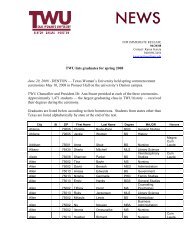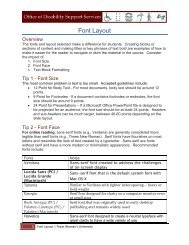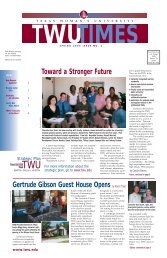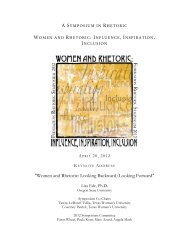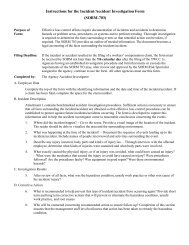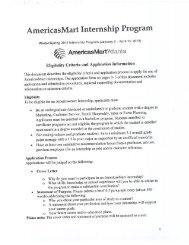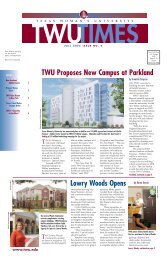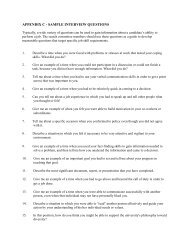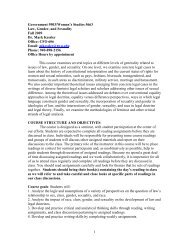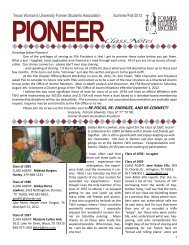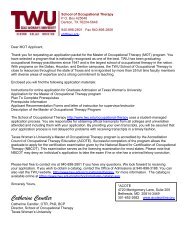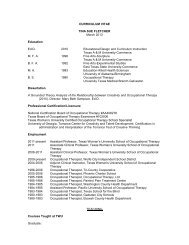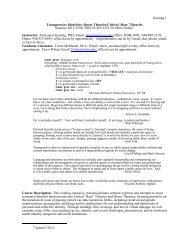HUMPHRIES' ASSESSMENT OF AQUATIC READINESS (HAAR) A ...
HUMPHRIES' ASSESSMENT OF AQUATIC READINESS (HAAR) A ...
HUMPHRIES' ASSESSMENT OF AQUATIC READINESS (HAAR) A ...
Create successful ePaper yourself
Turn your PDF publications into a flip-book with our unique Google optimized e-Paper software.
HUMPHRIES’ <strong>ASSESSMENT</strong> <strong>OF</strong> <strong>AQUATIC</strong> <strong>READINESS</strong> (<strong>HAAR</strong>)<br />
A PR<strong>OF</strong>ESSIONAL PAPER<br />
SUMITTED IN PARTIAL FULFILLMENT <strong>OF</strong> THE REQUIRMENTS FOR THE<br />
MASTER’S <strong>OF</strong> SCIENCE DEGREE<br />
TEXAS WOMAN’S UNIVERISTY<br />
DEPARTMENT <strong>OF</strong> KINESIOLOGY<br />
ADAPTED PHYSICAL EDUCATION AND ACTIVITY<br />
BY<br />
KELLEY M. HUMPHRIES, B.S.<br />
DENTON, TEXAS<br />
MARCH 2008
Table of Contents<br />
I. Author’s Note<br />
II.<br />
Introduction<br />
Aquatics and Special Populations 5<br />
Least Restrictive Environment and<br />
Individuals with Disabilities Act of 2004 5<br />
III.<br />
Assessments in the Adapted Aquatic Setting<br />
Purpose and Importance 6<br />
Current Adapted Aquatic Assessments 6<br />
The Halliwick Method 11<br />
IV.<br />
Humphries’ Assessment of Aquatic Readiness (<strong>HAAR</strong>)<br />
Development 15<br />
Interrater Reliability 20<br />
Face Validity 21<br />
<strong>HAAR</strong> Instrument 22<br />
Phases of <strong>HAAR</strong> 23<br />
Phase 1: Mental Adjustment 23<br />
Phase 2: Introduction to the Water Environment 23<br />
Phase 3: Rotations 24<br />
Phase 4: Balance and Controlled Movement 24<br />
Phase 5: Independent Movement in Water 25<br />
Directions for Administration 25<br />
Interpretation of Scores 26<br />
2
V. Activities for Phases<br />
Bath Time 27<br />
Water Simon-Says 28<br />
Shower Time 30<br />
Human Fountain 31<br />
Human Motor Boat 32<br />
Alligator Roll I 33<br />
Water-Tug-of-War 35<br />
Alligator Roll II 36<br />
Noodle Kick I 37<br />
Noodle Kick II 39<br />
Superman 40<br />
Noodle Float 41<br />
Hula-Hoop Swimming 42<br />
VI.<br />
References<br />
3
Author’s Note<br />
The development of the Humphries Assessment of Aquatic Readiness (<strong>HAAR</strong>)<br />
stemmed from my experiences with individuals with disabilities in the aquatics setting.<br />
During my experiences I learned that the most affect way to instruct individuals in the<br />
aquatics setting was provide an environment for these individuals that would provide<br />
them the optimal chance for success.<br />
In searching for an assessment instrument that encouraged and nurtured this type<br />
of environment, I came across the Halliwick Method. This teaching method provides the<br />
means to create that type of environment. This assessment and the activities associated<br />
with it were developed in hopes to provide the adapted aquatics community with an<br />
instrument to ensure that instruction specific to the needs of the student would be able to<br />
be provided.<br />
4
Introduction<br />
Aquatics and Special Populations<br />
The aquatic environment has been shown to provide improvements in many areas<br />
for individuals with disabilities. The aquatics environment has been used to aid in the<br />
promotion of improved health and fitness; as well as providing social benefits and<br />
promoting self-esteem (Block & Constar, 2007). The physical capabilities of individuals<br />
with neuromotor impairments and with mild spastic dipleia have been improved with the<br />
use of the aquatic environment (Getz, Hutzler, & Vermeer, 2006; Mackinnon, 2003). The<br />
aquatic environment can also promote an increase in morale and body image (Benedict &<br />
Freeman, 1993), improvement in mood (Berger & Owen, 1992), and a decrease in<br />
depression in most individuals with disabilities (Stein & Motta, 1992). The benefits that<br />
the aquatics environment can provide for individuals with disabilities make it a useful<br />
tool for professionals in adapted physical education and activity.<br />
Least Restrictive Environment and Individuals with Disabilities Act of 2004<br />
The benefits of an aquatics program can provide a student with a disability the<br />
chance to interact and engage in activities in a least restrictive environment (LRE).<br />
Establishing a LRE is a goal of the Individuals with Disabilities Education Act (IDEA,<br />
2004). It states that to ensure the rights for students with disabilities, education in the<br />
LRE must be ensured. This means that the student has the right to be educated in an<br />
environment with as little modifications and restrictions as possible, and with the<br />
assurance that he/she will be provided with enough support to be successful in that<br />
educational setting. The law’s purpose is to ensure that students with disabilities are<br />
given “free and appropriate public education; nondiscriminatory testing, evaluation, and<br />
5
placement procedures; education in the least restrictive environment; [and] procedural<br />
due process of the law” (IDEA, 2004).<br />
Assessments in the Adapted Aquatics Setting<br />
Purpose and Importance<br />
In order to ensure that a student is able to participate in an aquatics program<br />
his/her present level of functional performance must be determined. The student’s present<br />
level of functional performance provides the instructor with information on that student’s<br />
strengths and weaknesses.<br />
A very effective assessment method is the use of a screening or testing instrument<br />
(Silliman-French et al., 2005). Along with providing information on the student’s present<br />
level of functional performance, an assessment instrument provides a guide for the<br />
development and determination of the type of service and instruction the student requires.<br />
Its also provides a method for the measurement of the student’s achievement thought out<br />
the instructional program (Silliman-French, et al., 2005).<br />
Current Adapted Aquatics Assessments<br />
There are many assessments that are used in adapted aquatics. These assessments<br />
are based on a variety of different teaching methods. These methods range from assessing<br />
the student’s water orientation to the student’s swimming skills.<br />
The learn-to-swim progression model is the most common teaching method used<br />
(Gelinas & Reid, 2000). This method follows a sequential format and is developmental in<br />
nature thus forcing the student to complete the components in a sequential manner. The<br />
challenges that are associated with this method are that the validity of the assessment can<br />
be compromised. In order for an assessment to be considered a valid developmental<br />
6
assessment instrument, it must have different developmental levels of any skill that it is<br />
assessing. Also, it must demonstrate an order or change, and stability of the skills<br />
behavior across all persons at any point in time (Langendorfer & Bruya, 1995). The<br />
assessment should take into consideration the ultimate goals of the instructor and/or<br />
program, be aware of variations in teaching practices, and be able to provide a means for<br />
parallel programs to be implemented (Gelinas & Reid, 2000). With these qualities, an<br />
assessment is better equipped to provide the instructor with a more thorough<br />
understanding of the student and his/her capabilities. It is also able to provide the<br />
instructor with information on where the student is developmentally. This understanding<br />
allows the instructor to provide the student with the instruction that will best benefit<br />
his/her specific aquatic development.<br />
With the traditional assessment approach (a) a predetermined list of skills are set<br />
(b) a standardized progression of teaching is implemented (c) and a posttest is used to<br />
determine the student’s performance (Langendorfer & Bruya, 1995). Figure 1 shows how<br />
these components are implemented within the traditional model.<br />
Predetermined list of<br />
skills<br />
Standardized progression<br />
of teaching<br />
Posttest performance<br />
checklist (including<br />
combined test)<br />
Figure 1: Traditional aquatic assessment model. Adapted from Langenforfer & Bruya,<br />
1995, p. 19.<br />
The Lone Star Adapted Aquatics Assessment Inventory and Curriculum (LSAA)<br />
(Apache, Hisey, & Blanchard, 2005), Developmental Aquatics Assessment<br />
(Developmental), The Aquatic Readiness Assessment (ARA) [Langendorfer & Bruya,<br />
7
1995], Conatser Adapted Aquatics Screening Test, and Project Inspire Aquatic<br />
Assessment are among the assessments used in the adapted aquatics settings. Table 1<br />
shows what components each aquatic assessment contains. Many of these assessments<br />
follow the traditional, learn-to-swim progression model—ARA does not follow this<br />
model. Only one of the assessments has document validity and reliability.<br />
Table 1<br />
Components of popular aquatic assessments<br />
Aligned<br />
Different curriculum/<br />
Initial<br />
Levels Activities Test Validity Reliability Safety<br />
LSAA Yes Yes Yes Yes No Yes<br />
ARA Yes Yes No Yes Yes No<br />
Inspire Yes No No No No No<br />
Conatser No No No No No No<br />
Developmental No No No No No No<br />
*modified from Bowerman, 2007<br />
Many of the assessments have a few or none of the listed components. The question<br />
arises why are these particular components essential for an adapted aquatic assessment?<br />
Without these particular components it is probably that the assessment will not provide a<br />
complete understanding of the student’s capabilities (Langendorfer & Bruya, 1995;<br />
Sherrill & Silliman-French, 2004), thus limiting the choices of activities that can be<br />
provided for the student. This is due to the limited amount of information that can be<br />
8
obtained on the student from these assessment instruments. The more the instructor<br />
knows about the student’s capabilities the more choices he/she has in developing an<br />
individualized program for the student. The limited information that is provided by the<br />
assessment can lead to a decrease in the validity of the instructional program of the<br />
student. This is due to the increased possibility that there were no allowances for different<br />
developmental levels of the skills, a regular order or change for allowances for all<br />
persons, and stable forms of behavior at any point in time in the assessment instrument<br />
(Langendorfer & Bruya, 1995). If any of these components are missing from the<br />
assessment instrument it decreases its validity thus affecting the validity of the<br />
instructional program developed based on the assessment.<br />
There is also a lack of scientific foundation in many traditional assessment<br />
instruments. Many of these assessments have been developed by being “’piggy-backed’<br />
on preexisting [agencies] learn-to-swim programs” (Langendorfer & Bruya, 1995). This<br />
“piggy-backing” does not provided the assessment with a well documented, scientific<br />
foundation that enhances its capabilities of affectively determining the student’s aquatic<br />
competencies and capabilities. The lack of a scientific foundation in these assessments<br />
can posse a concern when the guidelines of IDEA, 2004 and No Child Left Behind Act<br />
(NCLB, 2001) are taken into consideration.<br />
Many traditional aquatic assessment instruments do not allow for changes in<br />
administration to address individual learning ability of students with disabilities. Strict<br />
adherence to the administration procedures of these assessments are needed to ensure that<br />
the reliability of the test and the validity of the test are not compromise. Strict adherence<br />
to the administration procedures and the assessment’s methodical bases rooted in a<br />
9
traditional approach can produce a situation in which the student with a disability is put at<br />
a significant disadvantage. This was seen when national education standards and district<br />
wide assessments began. The Goals 2000; Education America Act of 1994, PL 103-227<br />
started this trend (Kleinert & Kearns, 2001). When this law was implemented many<br />
students with disabilities were scoring so low that administrators began to exclude them<br />
in “the general education curriculum, its standards, and its comprehensive testing<br />
movement” (Sherrill & Silliman-French, 2004).<br />
Although these assessment present challenges for the instructor in gathering valid<br />
data on the student they do provide an instrument forth instructor to attempt to establish a<br />
present level of functional performance for the student this could be why these<br />
instruments are so widely used in adapted aquatics programs.<br />
Many of these popular assessments are very easy for the aquatics instructor to use.<br />
They are formatted in a task-analysis skill sheet. A task-analysis assessment is where a<br />
checklist format is used to keep track of the tasks that the student is able to accomplish<br />
and the next task that the student is to perform. This provides an easy assessment<br />
instrument for the aquatic instructors. The task-analysis assessment provides the<br />
instructor with a clear indication of what task the child is and is not capable of doing.<br />
Although formatted with the “user friendly” task-analysis structure, many of the<br />
assessments that are solely based on traditional approaches to teaching aquatic skills are<br />
rooted in content-reference criteria. Assessments based on content-reference focus on<br />
measuring what the teacher has or will teacher the student (Sherrill & Silliman-French,<br />
2004). The challenge with the content-referenced approach is that the instructor is limited<br />
in the data that are able to be obtained on the student. Since some of these popular<br />
10
aquatics assessments are based on traditional teaching methods, they provide limited<br />
flexibility in the determination of the student’s present level of performance. The<br />
assessment is geared toward what has already been predetermined by the teacher rather<br />
than determining the student’s capabilities. More flexibility is needed in assessing<br />
students’ aquatics skills, especially those with disabilities.<br />
The Halliwick Method<br />
The Halliwick Method was developed by James McMillan in 1949 (Martin,<br />
1981). Researchers have shown improvements in overall aquatic capabilities in<br />
individuals with disabilities when they have been exposed to the Halliwick Method of<br />
aquatic instruction (Martin, 1981). It has also been reported that the Halliwick Method of<br />
aquatic instruction is safe for people of all ages and with many types of disabilities<br />
(Mackinnon, 2003).<br />
The Halliwick Method was designed with consideration to different needs and<br />
ability levels of individuals with disabilities (Nicol, Schmidt-Hansberg, & McMillan,<br />
n.d). The method allows for the individual to be able to control the movements of his/her<br />
unique body (Nicol et al., n.d). The method also takes into consideration that the<br />
“physical requirements [of aquatic safety and skills] cannot be dissociated from mental<br />
reaction [and that this] may result from a situation involving loss of balance [in the<br />
aquatic environment]” (Nicol, Schmidt-Hansberg, & McMillan, n.d, p. 173).<br />
The Halliwick Method utilizes the natural progression of the way humans acquire<br />
physical movements. This progression starts with a mental adjustment to the activity and<br />
the factors associated with it. After mental adjustment has been accomplished balance<br />
restoration—which can also be considered gross patterns of the movement—is<br />
11
established and achieved. When the individual has accomplished balance restoration,<br />
prevention of loss of that balance while maintaining the initial position or posture of the<br />
task can be achieved. This step is known as inhibition. The final step in the progression is<br />
that the individual is able to facilitate—capable of mentally and physically controlling the<br />
overall movement—the task (Nicol, Schmidt-Hansberg, & McMillan, n.d). From this<br />
normal progression, the phases of the Halliwick Method were developed.<br />
The Halliwick Method is broken down into mental adjustment, balance,<br />
restoration, inhibition, and facilitation (Nicol et al., n.d). With the scientific principles of<br />
hydrodynamics and body mechanics driving it, these components were placed into one of<br />
four different phases. The hydrodynamic and body mechanics principles associated with<br />
the Halliwick Method focus on the ability to maintain a floating position. According<br />
Nicol, Schmidt-Hansberg, and McMillan, there are two different approaches that can be<br />
utilized in order to understand how to achieve different floating positions. The first<br />
approach was developed by Nicol and Krüger in 1979. It utilizes a capacitance-type<br />
waterproof force platform. The platform is placed on the bottom of the pool under the<br />
individual. This provides a buoyant force thus influencing changes in the shape of the<br />
body on the supportive buoyant force that is keeping it afloat. The second approach uses<br />
a wooden model of the body to help understand how different positions that the body can<br />
take in the water can affect its capability to float. This model creates differences in<br />
overall body density by having the capability to replace some of the wooden limbs with<br />
limbs that are filled with various things (e.g. air and lead).<br />
From the approaches used to understand how to achieve different floating<br />
positions, Nicol, Schmidt-Hansberg, and McMillan also identify two ways to correct<br />
12
problems associated with an individual’s capability to float. These two techniques are<br />
based on the biomechanical and hydrodynamic principles previously discussed. The first<br />
technique is to provide compensations for problems that prevent the individual from<br />
being able to maintain a horizontal position in the water. Individuals that have difficulties<br />
with this tend to move to a vertical position due to the dispersion of their density across<br />
different parts of their body. In most instances the density of their legs is around 1.2 and<br />
the density of their trunk is around 0.8. The differences in these densities generate an<br />
angular moment that causes the person to move back into a vertical position. The second<br />
is to prevent the individual from rotating around his/her longitudinal axis. This occurs<br />
when “the movement of inertia is smaller compared with that of the transverse axis, so<br />
the body is in a state of critical equilibrium when it is displaced from the symmetrical<br />
position by more that 15°” (Nicol, Schmidt-Hansberg, & McMillan, n.d, p. 176).<br />
The Halliwick Method also focuses on allowing the individual to become fully<br />
independent of the instructor in the aquatic environment. In order to achieve this the<br />
individual is made to be able to restore himself/herself back to a supine position when<br />
he/she has come to the prone position by accident, and bring himself/herself back to a<br />
standing position in the water. The student must also be able to safely return to a<br />
swimming position (Nicol, Schmidt-Hansberg, & McMillan, n.d).<br />
This foundation helps explain and aid in understanding of the body’s natural<br />
response and progression in the aquatic environment. The method is designed to be<br />
implemented in a one-to-one teaching ratio (Martin, 1981). This allows for individual<br />
instruction. The instructor is able to follow the progression of the method with the student<br />
at the student’s pace. Furthermore, the method does not solely follow a learn-to-swim<br />
13
progression. It is rooted more in the biomechanical principles association to the aquatic<br />
environment. This allows the instructor to teach and take into consideration challenges or<br />
factors associated with not just the student’s disability but also the environment—the<br />
water—the goals of the aquatic program, and the functional aspects of the skills that have<br />
been determined to be taught. The instructor is thus able to teach the components of<br />
aquatic skills that are most beneficial and appropriate for the student. This allows the<br />
instructor to provide the student with the basic fundamental components of aquatic<br />
safety.<br />
These fundamental components ultimately lead to the student becoming capable<br />
of being in the aquatic environment independently. As the student works to gain<br />
independence in the water he/she is also able to become a part of the unit or class while<br />
maintaining the one-to-one instructional setting. This allows the student to learn in a LRE<br />
(Martin, 1981). The student will be able to take advantage of the social interaction with<br />
his/her peers and still be able to benefit from the “unobtrusive yet constant attention”<br />
(Martin, 1981, p. 288) of his/her own personal instructor. The Halliwick Method also<br />
provides games and group activities that are specific to the principles of the method<br />
(Martin, 1981).<br />
It is the recommended by the author that no artificial floatation devices are used to<br />
ensure that the student is able to gain and maintain independence in the water. The<br />
rationale behind this is that individuals with disabilities are burdened on land with aids<br />
and there is no desire to introduce them to more aids in the aquatic environment. Once<br />
the student is able to understand proper behavior and control in the aquatic environment<br />
he/she is able to become independent in the water. Once independence is achieved, basic<br />
14
aquatic principles such as safe positions for breathing, regaining a lost position, and<br />
control of exhalation when are under water are implemented into the program. Although<br />
the Halliwick Method is developmental in its approach, it allows for modifications for<br />
individuals that may have inconsistencies in the developmental process (Martin, 1981).<br />
These inconsistencies are expected in individual with disabilities.<br />
An assessment instrument utilizing the Halliwick Method as its foundation has<br />
not been developed. The purpose of the manual is to provide an assessment instrument<br />
developed according to the foundations of the Halliwick Method. This manual will also<br />
provide activities for each phase of the developed aquatic’s assessment in order to<br />
provide instructors with a curriculum to follow that supports the concepts and principles<br />
of the Halliwick Method and basic aquatic readiness and competencies.<br />
Humphries’ Assessment of Aquatic Readiness (<strong>HAAR</strong>)<br />
Development<br />
The Halliwick Method has 10 stages that are divided into 4 phases (Martin, 1981):<br />
(a) Adjustment to Water, (b) Rotations, (c) Control of Movement in Water, and (d)<br />
Movement in Water. Phase 1 contains the stages of mental adjustment and<br />
disengagement. Phase 2 has the stages of vertical rotation, lateral rotation, and combined<br />
rotation. Phase 3 has the stages of up thrust, balance, and mental inversion. Phase 4 has<br />
the stages of simple progression, basic progression, and turbulent gliding (Nicol,<br />
Schimidt-Hansberg, & McMillan, n.d.). In order to develop an assessment based on the<br />
foundational aspects of the Halliwick Method certain criteria were set to ensure that the<br />
assessment developed would reflect the Halliwick Method as well as the components<br />
listed in Table 1.<br />
15
The some of the criteria set was based on the criteria of the aquatic assessment set<br />
forth by Langendorfer and Bruya (1995). According to Langendorfer and Bruya, the<br />
traditional approach to teaching is that of the use of a predetermined list. This list is of<br />
water skills that have been identified by the aquatic program to be learned by the student.<br />
These components that have been identified are then incorporated into a single teaching<br />
progression and then measured for achievement by a post-test checklist.<br />
In an alternate approach “water competence” and “aquatic readiness” are the fore<br />
front of the assessment (Langendorfer & Bruya, 1995). This approach allows for the<br />
assessment to provide more information about the student’s aquatic abilities. This is<br />
achieved because of the many different means of instruction that are provided once the<br />
assessment is complete. Using the alternate approach the assessment provides the<br />
instructor with better planning opportunities and can improve the teaching progression<br />
thus leading to an overall improvement of the aquatic program (Langendorfer & Bruya).<br />
Alternate approaches to assessments have been increasingly incorporated into<br />
administrating and developing assessments in adapted physical education. This is due to<br />
the exclusion of students with disabilities that has occurred. IDEA, 1997 required that<br />
there be full participation in the general education curriculum by students with disabilities<br />
unless there was justification other wise by the student’s Individualized Education Plan<br />
(IEP). IDEA, 1997 also required that general education teachers—classroom and physical<br />
education alike—provided accommodations and modifications for students with<br />
disabilities in the assessment setting. This law brought about many changes in the<br />
administration and development of assessments. These changes included<br />
16
“(a) an increased interest in ecological assessments, which gather and<br />
synthesize information about both the individual and the environment<br />
rather than assuming the problem or weakness is totally within the<br />
individual (b) broadening the placement concept from a continuum of<br />
[LRE] to include supports, supplementary aids, and services in general<br />
education settings, (c) and innovation of new practices.” (Sherrill &<br />
Silliman-French, 2004, p. 144).<br />
The alternate approach to the assessment also ensures that the assessment can be<br />
used for all age levels and abilities, thus the criteria for the assessment was set to ensure<br />
that (a) the Halliwick Method would be complemented by the assessment created, (b) as<br />
much information about the student’s aquatic capabilities could be determined by the<br />
assessment, and (c) the validity of the assessment would not be compromised.<br />
Although the concepts of the alternate approach to assessments where placed as<br />
the determinate of the components of the <strong>HAAR</strong>, it was understood that due to the<br />
developmental nature of the Halliwick method, certain components of the traditional<br />
assessments previously describes where used in order to ensure that the Halliwick<br />
Method was complemented by the assessment. Due to the convenient nature of a taskanalysis<br />
approach—described previously—a series of tasks were developed for each<br />
phase. These tasks were then listed in a “checklist” format and a number system applied<br />
to it to provide a clear scoring method. The tasks were determined based on the goals of<br />
the Halliwick Method and a number of different aquatics assessments that have been used<br />
by adapted aquatics instructors. A phase was added between Phase 1 and Phase 2 of the<br />
Halliwick Method labeled “Introduction to Water Environment” to reflect specific tasks<br />
17
that must be accomplished before the student is able to progress to Phase 2 of the<br />
Halliwick Method. This phase was based on Level 2 criteria in the LSSA (Apache, Hisey,<br />
& Blanchard, 2005).<br />
Due to the nature of the Halliwick Method, development of an assessment was a<br />
natural progression of the instructional method. The assessment is a hybrid between the<br />
structural components (e.g., the lay out of the assessment tool) of traditional assessments<br />
and the ideals of the alternative assessments. Since both methods haven shown to provide<br />
benefits to the assessment procedure, aspects from both were used aid in the development<br />
of the assessment. Due to the assessment’s roots in the scientific principles of<br />
biomechanics and hydrodynamics of the Halliwick Method, the assessment falls into the<br />
“innovative practices” (Sherrill & Silliman-French, 2004) concepts that have been<br />
integrated into assessments in adapted physical education. The assessment also focuses<br />
on concepts of aquatic readiness and competencies versus the learn-to-swim model. This<br />
aligns the assessment with the principles of the alternative approach to assessments<br />
developed by Langendorfer and Bruya (1994).<br />
The Halliwick Method shows the natural progression of the human body in the<br />
water, thus making it developmental and requiring that certain components be<br />
accomplished before advancement to another component can be achieved. This is a<br />
characteristic of the traditional approach to teaching. The Halliwick Method centers<br />
theses components around the biomechanical and hydrodynamic principles thus ensuring<br />
that no matter the student’s disability, the student will be able to perform the skills in a<br />
manner that is in align with their skill level. This ensures that the student will be able to<br />
achieve the components of aquatic safety and readiness. If he/she is unable to do so at the<br />
18
time of the initial screen test, with the activities provided—that are based on scientific<br />
principles—the student will be able to achieve those components. A number of different<br />
methods can be implemented in order to ensure that the student is able to experience<br />
success thus giving the instructor a number of different ways to develop and implement<br />
the student’s instructional program. The instructor is not limited to one method of<br />
instruction and can ultimately provide the student with an instructional program that is<br />
developed to meet the specific needs of the student and to ensure that he/she is able to<br />
achieve the basic components needed in order to be independent and competent in the<br />
aquatic environment. Table 2 shows how the <strong>HAAR</strong> compares to the other aquatic<br />
assessments previously discussed.<br />
Table 2<br />
Components of popular aquatic assessments<br />
Aligned<br />
Different curriculum/<br />
Initial<br />
Levels Activities Test Validity Reliability Safety<br />
<strong>HAAR</strong> Yes Yes Yes Yes Yes Yes<br />
LSAA Yes Yes Yes Yes No Yes<br />
ARA Yes Yes No Yes Yes No<br />
Inspire Yes No No No No No<br />
Conatser No No No No No No<br />
Developmental No No No No No No<br />
* modified from Bowerman, 2007<br />
19
As Table 2 shows, the <strong>HAAR</strong> is composed of all of the components listed.<br />
Interrater Reliability<br />
Eight assessors were selected from the Texas Woman’s University (TWU)<br />
Adapted Aquatics Program. The assessors were students of the adapted physical<br />
education program at TWU skilled in the adapted aquatic assessments. The assessors<br />
were trained in the scoring and the administration of the <strong>HAAR</strong> (see Figure 2 for<br />
assessment instrument). They attend a training session and were allowed a practice trial<br />
with the assessment.<br />
The participants that were assessed were selected randomly from the students<br />
participating in the TWU Adapted Aquatics Program. Written consent was given for each<br />
student to participate in the aquatics program and in the study by their legal parent or<br />
guardian. The participants were between the ages of 3 and 17 and qualified for special<br />
education services as specified under IDEA, 2004.<br />
The assessment was administered in the one-to-one ratio as recommended by the<br />
Halliwick Method. It was the responsibility of administrator to determine if the student<br />
was able to perform the tasks listed on the assessment starting with Phase 1. The<br />
assessors conducted the assessment on two different occasions separated by one week.<br />
Due to the time lapse, the students being assessed were not allowed to participate in any<br />
additional aquatic programs during this time. This was to ensure the students would<br />
remain at their present level of aquatic performance. Each student was assessed by the<br />
same assessor.<br />
The assessors completed all demographics information listed on the assessment<br />
instrument prior to skill analysis. If the student was able to perform the task the<br />
20
administrator placed a 1 for that task and moved to the next. If the student was unable to<br />
perform that task the administrator gave them a 0 for that task and proceeded to the next<br />
task. The assessor also wrote comments regarding the student’s behavior or any other<br />
information that would aid in determining a present level of performance. Table 3 shows<br />
the results of the interrater reliability of the assessment.<br />
Table 3<br />
Interrater Reliability<br />
Number of Number of Intarater reliability<br />
Assessors agreements possible agreements coefficients<br />
Assessors 1 and 2 30 32 .9375<br />
Assessors 3 and 4 30 32 .9375<br />
Assessors 5 and 6 29 32 .90625<br />
*Reliability coefficients are between 0.00 and 1.00. The closer the coefficient to 1.00 the<br />
greater the intarater reliability.<br />
Face Validity<br />
The assessment was sent to five professionals in higher education that specialize<br />
in the area of adapted aquatics in order to determine its face validity. Along with the<br />
assessment that was sent to the professionals was a survey based on a five point Likert<br />
scale. The professionals were asked to read and review the assessment and complete the<br />
survey. The surveys were then returned to the kinesiology department at TWU where<br />
they were reviewed.<br />
21
Student’s Name:______________________<br />
Student’s Age:___________<br />
Humphries’ Assessment of Aquatic Readiness<br />
(<strong>HAAR</strong>)<br />
Evaluator’s Name:________________________<br />
Date of Evaluation:_______________________<br />
Phase 1:Mental Adjustment<br />
___Will play with toy on pool deck<br />
___Will sit on the steps of the pool<br />
___Will enter/exit the pool by<br />
instructor carrying them<br />
___Will enter/exit the pool by<br />
holding the instructor’s hand<br />
___Will enter/exit the pool without<br />
holding the instructor’s hand<br />
Score: ____/5<br />
Percentage:___%<br />
Phase 2: Introduction to water<br />
environment<br />
___Will splash water with hands<br />
with the instructor’s support<br />
___Will splash water with hands<br />
without the assistance from the<br />
instructor<br />
___Will touch chin to water<br />
___Will touch ear to water<br />
___Will touch mouth to water<br />
___Will blow bubbles in water<br />
___Will perform shipping action<br />
with mouth<br />
___Will allow water to be poured on<br />
head<br />
___Will place head in water<br />
independently<br />
___Will place head in water<br />
independently and come up with<br />
minimal water consumption<br />
Score:____/10<br />
Phase 3: Rotations<br />
___Will perform a vertical/forward<br />
rotation (roll from supine<br />
position to standing position in<br />
the pool)<br />
___Will perform a lateral rotation<br />
(roll from supine position to<br />
prone position and back to<br />
supine)<br />
___Will perform a combined<br />
rotation (go from standing in the<br />
water to prone position and then<br />
rotate to supine position)<br />
Score:_____/3<br />
Percentage:___%<br />
Phase 4: Balance and Controlled<br />
Movement<br />
___Will reach from standing position<br />
for toy on first pool step without<br />
assistance<br />
___Will reach from standing position<br />
for toy on tot dock or from the<br />
bottom of the pool without<br />
assistance<br />
___Will allow instructor to move<br />
them passively through the<br />
water in the prone position<br />
___Will allow the instructor to move<br />
them passively through the water<br />
in the supine position<br />
___Will kick legs with instructor’s<br />
support<br />
___Will move arms in rudimentary<br />
pattern with instructor’s support<br />
___Will move arms with straight<br />
over arm motion with<br />
instructor’s support<br />
___Will kick legs with straight<br />
pattern with instructor’s support<br />
Phase 5: Independent movement in<br />
water<br />
___Will float supine unassisted<br />
___Will glide from side of pool to<br />
instructor independently<br />
___Will glide with bent leg kick to<br />
instructor independently<br />
___Will glide with straight leg kick<br />
to instructor independently<br />
___Will come to instructor with<br />
straight leg kick and<br />
rudimentary arm movements<br />
independently<br />
___Will come to instructor with<br />
straight leg kick and straight<br />
over arm independently<br />
Score:____/6<br />
Percentage:___%<br />
Percentage:___%<br />
Score:_____/8<br />
Corrective methods suggested for buoyancy and floatation:<br />
Percentage:___%<br />
Figure 2: Humphries’ Assessment of Aquatic Readiness Instrument (<strong>HAAR</strong>)
Phases of <strong>HAAR</strong><br />
Phase 1:<br />
Mental Adjustment<br />
Phase 1 is critical in understanding how the student is going to react to the aquatic<br />
environment. It includes the mental adjustment component of the Halliwick Method. It<br />
allows the instructor to look at the comparisons of the student’s posture and movement in<br />
the aquatic environment versus the student’s posture and movement on land (Nicol,<br />
Schmidt-Hanseberg, & McMillan, n.d). It also takes into account that there are two forces<br />
acting on the body in the aquatic environment—gravity and buoyancy—versus one on<br />
land—gravity. This phase provides the instructor with information on the student’s<br />
comfort level with the water and willingness to be in the water. According to the<br />
Halliwick Method, it is first step of development in the aquatic environment. In order for<br />
the student to be successful in the aquatic environment, he/she must have the correct<br />
mental adjustment. Without this, the student will not be able to be successful.<br />
Phase 2:<br />
Introduction to the Water Environment<br />
Phase 2 is not one of the original 4 phases in the Halliwick Method. It was<br />
developed for the <strong>HAAR</strong> to ensure that the student would be able to successfully<br />
transition from the mental adjustment phase to being able to perform the rotations<br />
specified by the Halliwick Method in the aquatic environment.. Unlike the Halliwick<br />
Method, this assessment incorporates the disengagement step into Phase 2. In order to<br />
affectively incorporate this component into the newly developed phase the concepts from<br />
Level 2 in the LSSA were used. This phase ensures that the student is able to be<br />
comfortable in the water and perform actions that will cause water to be on their face and<br />
around their mouth in a safe manner. Such tasks are independently splashing in the water,
lowing bubbles without consuming the water, and submerging his/her head in the water<br />
without consumption of the water.<br />
Phase 3:<br />
Rotations<br />
Phase 3 shows the first steps toward aquatic independence for the student. This<br />
phase is described as one of the most important phases of the Halliwick Method. It<br />
ensures that the student is able to move his/her body in the different fundamental<br />
positions safely in the water. These are fundamental in that they allow the student to<br />
place themselves in the necessary positions to safely and affectively move in the aquatic<br />
environment. These rotations are the initial steps to more complex movements such as<br />
freestyle swimming and the breast stroke. They are also the foundation for safely entering<br />
and exiting the pool by the side of the pool without assistance of the pool steps. The<br />
rotations to be achieved are the vertical rotation which is controlled movement around the<br />
transverse axis. The lateral rotation which is controlled movement across the longitudinal<br />
axis. The combined rotation which is controlled movement along the diagonal axis<br />
(Nicol, Schmidt-Hansberg, & McMillan, n.d.).<br />
Phase 4:<br />
Balance and Controlled Movement<br />
Phase 4 shows that the student is able to control his/her movements in the water<br />
independently. The phase includes the components of mental inversion and balance.<br />
These tasks ensure that the student is able to control the movements of their body against<br />
the force of the water. It also ensures that the student is comfortable and capable of<br />
performing the rudimentary movements of more complex skills in the water (e.g.,<br />
independent swimming) and opposing the affects of the buoyancy in order to stay under<br />
the water when appropriate (Nicol, Schmidt-Hansberg, & McMillan, n.d.).<br />
24
Phase 5:<br />
Independent Movement in Water<br />
Phase 5 indicates that the student is capable of being in the aquatic environment<br />
independently. This phase ensures that the student is able to perform task pertaining to<br />
turbulent gliding and simple progression. It also ensures that the student is able to<br />
perform basic movements. These movements are based on hydrodynamic principles and<br />
can be performed by 70% of individuals with a disability (Nicol, Schmidt-Hansberg, &<br />
McMillan, n.d.).<br />
Directions for Administration<br />
The assessment is to be administered in a 1 to 1 teacher:student ratio as<br />
recommended by the Halliwick Method. The assessor is to ensure that he/she fills out the<br />
demographics on the assessment instrument. For each task that the student is able to<br />
complete he/she is given a score of “1.” If the student is unable to complete the task<br />
he/she is given a score of “0.” At the end of the assessment the assessor adds up the<br />
student’s total score for each phase. This total is to be recorded for each phase in the<br />
space provided on the assessment instrument.<br />
The percentage of each phase is then determined. In order to determine the<br />
percentage for each phase, the student’s score for that phase is taken and then divided by<br />
the total possible points for that phase. The total points for each phase is listed in bold in<br />
each phases’ box. In the following example the number acquired from dividing the<br />
student’s total score by the total possible points for that phase is then multiplied by 100 to<br />
obtain the students percentage for that phase (see Example).<br />
25
Example:<br />
Student’s total score for Phase 1: 4<br />
Possible points for Phase 1: 5<br />
4 ÷ 5 = 0.8<br />
0.8 X 100 = 80%<br />
Percentage score for Phase 1: 80%<br />
Interpretation of Scores<br />
The final percentage scores that are derived from the assessment indicate the<br />
student’s weaknesses and strengths. The phase that the student scored the highest in<br />
indicates their greatest strengths. The phase that the student scored the lowest in indicates<br />
their greatest weaknesses. From this information the assessor can determine what areas<br />
the student needs the most work on and proceed accordingly.<br />
Activities for Phases<br />
Dependant upon what the student’s weaknesses and strengths this manual can be<br />
used to determine the appropriate activities to perform with the student in the<br />
instructional setting. The activities for this manual are organized according to the phases<br />
of the assessment. These activities promote advancement through that particular phase.<br />
This ensures that the student will become successful at all the tasks presented in that<br />
particular phase and ultimately be able to move to the next phase.<br />
In this section, activities to support the <strong>HAAR</strong> assessment will be presented. Each<br />
activity has the following components:<br />
1. Activity Name<br />
2. Target Task(s): the task the activity is working on<br />
26
3. Equipment<br />
4. Formation: the formation can be individual, small groups, or in a large<br />
group. In the large group setting each student should have an individual<br />
instructor so that the instructional setting is true to the Halliwick Method.<br />
5. Procedures<br />
6. Variations/Modification<br />
7. Diagram of Activity<br />
Phase 1: Mental Adjustment<br />
Activity<br />
Bath Time<br />
Target Task(s)<br />
Entering the pool with assistance from the instructor or independently.<br />
Equipment<br />
None required but you can use “bath-time” objects to help set the environment of<br />
the activity.<br />
Formation<br />
Can be performed one-on-one, in a small group, or a large class.<br />
Procedures<br />
The instructor will inform the student that he/she is going to play in the “Big<br />
Bathtub.” The instructor will then ask the student to show how he/she gets into the<br />
bathtub at home. The student will then hold the instructor’s hand and step down to the<br />
first step in the pool. Once this has been achieved, the student has successfully entered<br />
the bath tube. This game can also be performed by having the student play with a bath toy<br />
27
on deck and gradually moving them to the<br />
“bathtub.” The instructor can then<br />
Show me how<br />
you get into the<br />
bathtub.<br />
gradually work the student to walking<br />
down all the steps until he/she is able to<br />
completely enter the pool. This can then<br />
lead into the next task of independent<br />
(walking down the stairs into the water<br />
.<br />
without the instructors support) entry thus a<br />
level of freedom reached by the student.<br />
Variations/Modifications<br />
If the student refuses to enter into the pool the instructor can put the student on a<br />
flotation device to get the student to enter the water. Note that this is used as a last resort<br />
and the instructor must work to remove the use of the device as soon as possible.<br />
If the student is a wheelchair user, the use of the lift to get the student into the<br />
pool may be used. A water chair may also be used for the student. This is a chair that can<br />
be set on the side of the pool in the water that allows the student to sit up right in the<br />
water with his/her legs and lower body submerged in the water.<br />
Activity<br />
Water Simon-Says<br />
Target Task(s)<br />
Entering the pool with assistance from the instructor or independently.<br />
28
Equipment<br />
None required but you can use toys as part of your commands for a more dynamic<br />
game.<br />
Formations<br />
Can be performed one-on-one, in a small group, or a large class.<br />
Procedures<br />
The student will engage in a game of “Simon Says” with the instructor being<br />
“Simon.” The game will start with simple tasks, such as “Simon Says touch your belly,<br />
and move to task specific to entry into the water. The object of the game is to get the<br />
student’s mind off of the water and on following “Simon’s” directions. This will aid in<br />
the student’s mental adjustment to the water by creating a smooth transition from the<br />
deck to the pool.<br />
Simon Says…pour<br />
water on the deck<br />
with the bucket.<br />
Simon<br />
Says…Stand on<br />
one foot in the<br />
water.<br />
Simon<br />
Says…Come<br />
towards me.<br />
Simon<br />
Says…Put<br />
your arms at<br />
your sides.<br />
.<br />
29
Variations/Modifications<br />
Have the student play the role of “Simon” so that a demonstration on how to enter<br />
the pool can be given. The use of toys can also be beneficial in the game by having the<br />
student retrieve the toys on the deck, the pool steps, or even a tot dock<br />
Phase 2: Introduction to the Water Environment<br />
Activity<br />
Shower Time<br />
Target Task(s):<br />
Getting various parts of the face wet with the assistance of the instructor.<br />
Equipment<br />
Shower areas, cup and/or sponge.<br />
Formation<br />
Can be performed one-on-one, in a small group, or a large class.<br />
Procedures<br />
Before the student and the instructor enter the pool (assuming the instructor and<br />
the student are of the same gender) they are to use the pool showers and act as if they are<br />
taking a shower. The instructor will model washing their hair and face. The student will<br />
model after the instructor. Once the shower is completed the student and the instructor<br />
enter the pool. The instructor will have a cup or sponge and will ask the student to pour<br />
water from it on his/her head to show how to wash his/her hair in the shower. The<br />
instructor will then ask the student to pour the water on his/her head and show how the<br />
student washes his/her hair in the shower.<br />
30
Variations/Modifications<br />
The student can begin by pouring water on his/her hands, then arms, then<br />
shoulders, then neck, and then head if a build up process is needed. This will provide the<br />
student with more independence and self-confidence.<br />
Activity<br />
Human Fountain<br />
Target Task(s)<br />
Performing a shipping action, independently getting various parts of the face wet.<br />
Equipment<br />
None required.<br />
Formation<br />
Can be performed one-on-one, in a small group, or a large class.<br />
31
Procedures<br />
The student is to be told that he/she and the instructor are human fountains. In<br />
order to become and human fountain he/she must gather water into his/her mouth and<br />
“spurt” it out like a fountain. It should be stressed that fountains “spurt” water out and<br />
that the water should not be swallowed. This action of taking in water and allowing it to<br />
leave the mouth is called shipping.<br />
Variation/Modifications<br />
None<br />
Activity<br />
Human Motor Boat<br />
Target Task(s)<br />
Blowing bubbles in the water, independently getting various parts of the face wet.<br />
Equipment<br />
Straw for modified game.<br />
Formation<br />
Can be performed one-on-one, in a small group, or a large class.<br />
32
Procedures<br />
The student is to be told that he/she and the instructor are the engine of a motor<br />
boat. The instructor demonstrates the sounds of the motor and how producing that sound<br />
creates bubbles in the water. The instructor then asks the student to perform the same<br />
actions.<br />
Variations/Modification<br />
If the student is having difficulty with blowing bubbles the instructor can give the<br />
student a straw to blow through. This will show the student the correct action to take for<br />
blowing bubbles.<br />
Phase 3: Rotations<br />
Activity<br />
Alligator Roll I<br />
Target Task(s)<br />
Performing a lateral roll<br />
Equipment<br />
A long flotation device.<br />
33
Formation<br />
Can be performed one-on-one, in a small group, or a large class.<br />
Procedures<br />
The student will be asked to lay on his/her stomach on a flotation device that<br />
looks like, or can be said to be, an alligator. The instructor will tell the student to roll<br />
from the alligator into his/her arms by moving from the prone position to the supine<br />
position--from lying on the stomach to lying on the back. The student will then roll off<br />
the alligator (in a barrel roll manner) into the instructor’s arms. This provides the student<br />
with confidence and security in the water.<br />
A<br />
B<br />
Variations/Modifications<br />
The instructor can have the student perform the roll on deck first before<br />
performing the roll in the water on the flotation device. For students that my have unique<br />
reflexes when placed on their stomach (e.g., some individual with cerebral palsy may<br />
experience inadvertent reflexes when placed on their stomach) a flotation belt can be<br />
used to aid them in the rotation but it is important that the student not become dependant<br />
34
on the device. If support is needed it is preferred that it is given in the form of support<br />
from the instructor.<br />
Activity<br />
Water Tug-of-War<br />
Target Task(s)<br />
Performing a vertical roll.<br />
Equipment<br />
A noodle or jump rope.<br />
Formation<br />
Can be performed one-on-one, in a small group, or a large class.<br />
Procedure<br />
The student will hold one end of the noodle or jump rope and the instructor will<br />
hold the other end. The instructor will demonstrate and explain to the student that each of<br />
them will take turns pulling each other until they are laying on their backs. Once on their<br />
backs, both the student and the instructor will have to demonstrate how to get themselves<br />
back to a standing position. When the student is on his/her back the instructor will need<br />
to move to help keep the student float.<br />
A<br />
B<br />
35
Variations/Modifications<br />
The instructor can start by having the student practice the movement while<br />
holding on to the side of the pool or holding the student’s hands. The instructor can also<br />
decide to not use the noodle or the jump rope at first and build up to it. A flotation belt<br />
can also be used to help the student get a feel for the movement but it is important that<br />
the student not become dependent on the flotation belt. If assistance is needed it is<br />
preferred that it is given in the form of support from the instructor.<br />
Activity<br />
Alligator Roll II<br />
Target Task(s)<br />
Performing a combined roll.<br />
Formation<br />
Can be performed one-on-one, in a small group, or a large class.<br />
Equipment<br />
None required.<br />
Procedures<br />
The student will be told that he/she is now the Alligator and to move like one. The<br />
student will perform the movements described in Alligator Roll I without the assistance<br />
of the flotation device. The student will start in a standing position in the water and then<br />
move to lying on his/her stomach in the water. Once the student is on his/her stomach, the<br />
student will roll until he/she is on his/her back. Once on his/her back, the student will<br />
move back to a standing position.<br />
36
A<br />
B<br />
C<br />
D<br />
Variations/Modifications<br />
A flotation belt can be used to help the students perform the movements but it is<br />
important that the belts only be used to give the student a feel for the rotations and that<br />
the student not become dependent on it. Once the student is able to perform the<br />
movement with the belt, the belt is to be removed. If assistance is needed it is preferred<br />
that it is provided by the support of the instructor rather than a flotation belt. The goal is<br />
to get the student to perform the task independently.<br />
Phase 4: Balance and Controlled Movement<br />
Activity<br />
Noodle Kick I<br />
37
Target Task(s)<br />
Kicking with a straight legged pattern.<br />
Equipment<br />
None required<br />
Formation<br />
Can be performed one-on-one, in a small group, or a large class.<br />
Procedures<br />
To help the student kick in a straight leg pattern a noodle will be placed under the<br />
student’s hips while on his/her stomach. The student will be instructed to kick his/her<br />
legs in order to move to the instructor. The noodle ensures that the only way the student<br />
will move is if he/she kicks with a straight pattern. Before the noodle is placed under the<br />
student’s hips the instructor should demonstrate the proper straight leg kicking pattern<br />
while holding on to the wall. The instructor should then allow the student time to practice<br />
the proper kicking technique. This provides the student with independence from the<br />
instructor<br />
Variations/Modifications<br />
None<br />
38
Activity<br />
Noodle Kick II<br />
Target Task(s)<br />
Move arms with rudimentary pattern or with straight over arm motion.<br />
Equipment<br />
Swimming Noodle.<br />
None required<br />
Formation<br />
Can be performed one-on-one, in a small group, or a large class.<br />
Procedures<br />
To help the student move his/her arms while in the prone position, a noodle will<br />
be placed under his/her stomach. The student will be instructed to move his/her arms in<br />
order to move towards the instructor. The instructor should be judge weather the student<br />
is ready to perform the straight over arm motion or just the rudimentary movement.<br />
Before the noodle is placed under the student the instructor should demonstrate the<br />
proper arm movements and allow the student to practice the movements from a standing<br />
position.<br />
Variations/Modifications:<br />
None<br />
39
Activity<br />
Superman<br />
Target Task(s)<br />
Moving passively through the water on stomach and back.<br />
Equipment<br />
None required.<br />
Formation<br />
Can be performed one-on-one, in a small group, or a large class<br />
Procedures<br />
The student will be told that he/she is superman. The instructor will aid the<br />
student in lying on his/her stomach. While supporting the student the instructor will move<br />
the student through the water in this position. The student will then move to lying on<br />
his/her back. The instructor will support the student and move them through the water in<br />
the same manner.<br />
A<br />
B<br />
Variations/Modifications<br />
None<br />
40
Phase 5: Independent Movement in Water<br />
Activity<br />
Noodle Float<br />
Target Task(s)<br />
Floating in supine position unassisted.<br />
Equipment<br />
Swimming Noodle.<br />
Formation<br />
Can be performed one-on-one, in a small group, or a large class.<br />
Procedures<br />
The noodle can be use to provide the student with the feeling of the correct<br />
placement of the hip while floating on his/her back. The noodle will help train the hips to<br />
hold the correct position. To prevent the student from becoming dependent on the noodle,<br />
it should not be held at the hips for too long while the student is floating on his/her back.<br />
In order to achieve this, the student will float on his/her back with or without the noodle.<br />
When the student is not using the noodle to perform the float, the instructor is to support<br />
the student’s head while he/she floats. The student will be timed to determine how long<br />
he/she can float under each condition.<br />
A<br />
B<br />
41
Variations/Modifications<br />
None<br />
Activity<br />
Hula-Hoop Swimming<br />
Target Task(s)<br />
Gliding to instructor independently, swimming to instructor with rudimentary and<br />
straight arm/leg patterns.<br />
Equipment<br />
Hula-Hoop.<br />
Formation<br />
Can be performed one-on-one, in a small group, or a large class.<br />
Procedure<br />
The student will start by holding on to the side of the pool. The instructor will<br />
stand some distance from the student with the Hula-Hoop. The student will be asked to<br />
move from the wall to through the Hula-Hoop by gliding or swimming. As the student<br />
improves his/her swimming technique the instructor will have the student swim using the<br />
straight arm/leg pattern.<br />
A<br />
B<br />
42
Variations/Modifications<br />
None<br />
43
References<br />
Apache, R.R., Hisey, P., & Blanchard, L. (2005). An adapted aquatics assessment<br />
inventory and curriculum. Palaestra, 21, 32-37.<br />
Benedict, A., & Freeman, R. (1993). The effect of aquatic exercise on aged persons bone<br />
density, body image, and morale. Activities Adaptations and Aging, 17, 67-85.<br />
Berger, B.G., & Owen, D.R. (1992). Mood alteration with yoga and swimming: Aerobic<br />
exercise may not be necessary. Perceptual and Motor Skills, 75, 1331-1343.<br />
Block, M.E. & Conaster, P. (2007). A teacher’s guide to including students with<br />
disabilities in general physical education. In M.E Block (3 rd Ed.), Including<br />
students with disabilities in general aquatics programs. Baltimore, MD: Paul H.<br />
Brooks.<br />
Bowerman, S. (2007). Assessment in Adapted Aquatics. Project Inspire. Texas Woman’s<br />
University. Retrieved 27 March 2008 from www.twu.edu/inspire.<br />
Gelinas, J.E., & Ried, G. (2000). The development of validity of traditional<br />
learn-to-swim progression for children with physical disabilities. Adapted<br />
Physical Activity Quarterly, 17, 269-285.<br />
Getz, M., Hutzler, Y., & Vermeer, A. (2006). Effects of aquatic interaction in children<br />
with neuromotor impairments: A systematic review of the literature. Clinical<br />
Rehabilitation, 20, 927-936.<br />
Goals 2000: Educate America Act of 1994, Public Law 103-227.<br />
Individuals with Disabilities Education Act (IDEA) Amendments of 1997, 20 U.S.C. § §<br />
1400 et.seq.<br />
44
Individuals with Disabilities Education Act (IDEA) Amendments of 2004.20 U.S.C. § §<br />
1400 et.seq.<br />
Kleinert, H.L., & Kearns, J.F. (2001). Alternate assessment: Measuring outcomes and<br />
supports for students with disabilities. Baltimore: Brookes.<br />
Langendorfer, S.J., & Bruya, L.D. (1995). Aquatic readiness developing water<br />
competence in young children. Champaign, IL: Human Kinetics.<br />
MacKinnon, K. (2003). University of Central England Case Study: An evaluation of the<br />
benefits of Halliwick swimming on a child with mild spastic diplegia.<br />
HalliwicAST. Retrieved from<br />
http://www.halliwick.org.uk/downloads/casestudy01.PDF.<br />
Martin, J. (1981). The Halliwick Method. Physiotherapy, 67, 288-291<br />
Nicol, K., Schmidt-Hansberg, M., & McMillan, M. (n.d). Biomechanical principles<br />
applied to the Halliwick Method of teaching swimming to physically handicapped<br />
individuals. Fundamentals of the Halliwick Method.<br />
Nicol, K., & Krüger, F. (1979). Impulses exerted in performing several kinds of<br />
swimming turns. In J. Terauds (ed.), Swimming III. University Park Press,<br />
Baltimore.<br />
No Child Left Behind Act (NCLB) 2001, Public Law 107-110.<br />
Sherrill, C. & Silliman-French, L. (2004). Assessment, the IEP, and the accommodation<br />
plan. In C Sherrill (6 th Ed), Adapted Physical Activity, Recreation, and Sport:<br />
Crossdisciplainary and Lifespan. New York, NY: McGraw-Hill.<br />
45
Silliman-French, L. et al., (2005). Texas association of health, physical education,<br />
recreation and Dance: Adapted Physical Education manual of best practices.<br />
TAHPERD: Austin, TX.<br />
Stein, P.N., & Motta, R.W. (1992). Effects of aerobic and nonaerobic exercise on<br />
depression and self-concepts. Perceptual and Motor Skill, 74, 79-89.<br />
46



